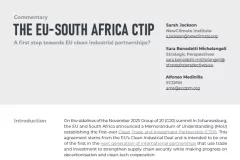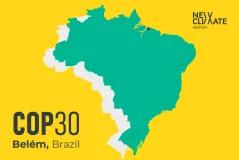Carbon offsetting creates false expectations for the Global South, as it may not provide the climate and financial benefits it claims. Instead, it enables companies to continue polluting by paying to "offset" their emissions, leaving the Global South to bear the brunt of delayed climate action. A more promising approach to channelling funds to the Global South could focus on directly addressing scope 3 emissions in supply chains.
Dubbed as the "finance COP,” the upcoming UN climate summit in Azerbaijan will centre on raising climate finance. Developed countries are expected to reach a new climate finance goal, known as the New Collective Quantified Goal (NCQG), to support developing countries’ climate action from 2025 onward. As rich countries grapple with the specifics of mobilising climate finance, their failure to meet financial commitments is driving developing nations to turn to voluntary carbon markets as a potential source of finance.
In June, a coalition of 10 developing countries sent a letter to the Science-Based Targets initiative (SBTi), the corporate climate-target verifier, urging it to incorporate carbon offsetting into its net-zero guidance for companies. This call was echoed by 105 community-based organisations in the Global South, which called on the SBTi to allow companies’ use of carbon credits to offset their scope 3 emissions and meet their net-zero goals.
“For far too long, despite big promises, the governments of the Global North have failed to deliver the requisite funding to the communities,” the group of Global South-based organisations wrote in their letter to SBTi. Supporting the statement released by the SBTi Board of Trustees in April, the organisations argued that carbon offsetting would “unlock more climate finance for natural assets and local communities in the Global South, accelerating global climate action.”
The appeals from countries and organisations in the Global South are a stark reminder of the desperate need for climate finance, which remains far below the required levels. To meet their climate and nature goals, emerging markets and developing countries, excluding China, will need about $2.4 trillion per year by 2030, according to the Independent High-Level Expert Group on Climate Finance.
To limit global warming to 1.5°C and address climate injustice – where the countries contributing the least to climate change are the most vulnerable to its impacts – much more financing is needed. However, it may be a myth that carbon offsetting will generate substantial cash flow for the Global South. There are significant caveats in carbon offsetting that could potentially harm developing countries rather than benefit them in the long run. In this blog post, our experts explain why.
Global South: victims of companies’ delayed climate action
Amid a shortage of climate finance, carbon offsetting has been often promoted as a key tool to attract investment from the private sector. In voluntary carbon markets, companies can purchase carbon credits from credit-generating projects aimed at removing or reducing greenhouse gas (GHG) emissions, such as reforestation and renewable energy expansion in the Global South. Each credit represents one metric tonne of greenhouse gas reduced, avoided or removed. Some companies use these credits to claim they have compensated for their emissions – a practice known as offsetting.
Currently, SBTi, a standard-setter guiding corporate climate actions to align with climate science, does not permit the use of carbon credits towards companies' GHG emissions reduction targets. It prescribes that companies prioritise direct emissions reductions across all emission scopes to meet their near-term and long-term climate goals.
Under mounting pressure, however, SBTi is exploring whether and how to allow carbon credits in meeting corporate climate targets for scope 3 emissions. Proponents of carbon offsetting for scope 3 emissions argue that the flexibility to use carbon credits could encourage more companies to address these emissions, which are released indirectly across companies’ value chains and account for the majority of a company’s total carbon footprint. But SBTI’s own analysis of scientific evidence on carbon offsetting confirmed the “clear risks to corporate use of carbon credits.” The analysis noted that carbon credit projects often fail to deliver their intended mitigation outcomes, posing a risk of reducing carbon finance and weakening net-zero transformations.
Carbon offsetting diminishes the incentive for companies to cut their emissions directly, as it offers a cheaper way to claim they meet their climate targets without making substantial emissions reductions efforts. This flexibility allows them to delay their decarbonisation measures while continuing to pollute. As long as offsetting remains an option in achieving climate targets, demand for low-quality, low-cost carbon credits, often from dubious projects, will likely persist. And with climate impacts unevenly distributed, the burden of delays in climate action will fall most heavily on developing countries and vulnerable communities.
A more promising approach to channelling funds to the Global South could be to focus on directly addressing their scope 3 emissions in their supply chains, according to NewClimate expert Thomas Day. This is important because most of a company's manufacturing supply chains, especially for labour-intensive industries like textiles or crop-intensive ones like agriculture, are based in the Global South.
“It’s a choice between making serious investments in the Global South to directly decarbonise material and manufacturing suppliers, or taking the cheap and easy way out,” Day said.
While decarbonising supply chains is challenging, direct investment in addressing scope 3 emissions could deliver more climate benefits for the Global South. For example, fashion companies, whose manufacturing bases are mostly in Southeast Asia, can proactively support suppliers in procuring renewable electricity and improving energy efficiency. And voluntary initiatives focused on mobilising more corporate action and climate finance can play a crucial role in supporting companies’ transition to decarbonisation. The initiatives can assist companies with capacity building, helping them to engage with their suppliers more effectively. They can also develop collaborative projects that pool resources from multiple companies to facilitate more efficient decarbonisation of similar suppliers.
“Addressing this issue by trying to fix the integrity of carbon crediting projects and offsetting claims is not the solution,” said Day. “Rather, we need to find ways to better incentivise and support companies to further explore the complex challenges associated with directly decarbonising their supply chains, which entails significant investments in the Global South.”
Claimed benefits of carbon offsetting may not reach the Global South
Despite promises of unlocking finance for developing nations, questions persist about whether the climate and financial benefits marketed by carbon credit projects actually reach the Global South. Numerous reports indicate that the primary beneficiaries of these projects are often project developers, international traders and brokers based in the Global North, rather than the local communities they are intended to support.
Currently, there is no robust system to ensure that the finance from carbon credit projects is directed to the intended beneficiaries, leading to opaque operations in voluntary carbon markets. This opacity makes it difficult to track the intermediaries involved, their profits and how much of the revenue actually goes towards mitigation efforts in the Global South. A recent report also found that nine out of 10 intermediaries in voluntary carbon markets do not disclose their fees or profit margins, and project developers and owners were predominantly based in the Global North.
This lack of transparency poses several problems. Firstly, it diverts funds away from genuine climate actions needed in the Global South, where they are most needed to mitigate and adapt to the impacts of climate change. There is a risk that funds often get lost in administrative costs and intermediary profits, benefitting project developers and intermediaries in the Global North. Secondly, this leads to a lack of accountability, with some project developers accused of exaggerating the climate benefits of their initiatives. In some cases, carbon credit projects have been criticised for harming local communities in the Global South by displacing them from their land for project use.
Simply improving safeguards and enhancing transparency in carbon credit projects cannot fix the underlying problems of voluntary carbon markets, which are driven by companies’ demand for cheaper, easier solutions to meet their climate targets, according to NewClimate expert Juliette de Grandpré.
A more equitable and transparent approach to mobilising funds for the Global South might be the climate contributions approach, she noted.
Under the climate contributions model, companies provide climate finance to support climate action beyond their own value chains without claiming to offset their actual emissions. By setting an internal carbon price on remaining emissions, companies generate a budget to directly invest in mitigation or other types of projects. Unlike carbon credit projects, climate contributions do not allow companies to count these emissions reductions towards their targets; instead, these reductions count towards a host country’s mitigation goals. This approach could help developing countries achieve their own climate goals instead of conflicting with them.
SBTi also suggests that climate contributions, also referred to as Beyond Value Chain Mitigation, are preferable models for accelerating companies’ decarbonisation and mobilising climate finance.
Climate contributions could also encourage investment in projects that voluntary carbon markets are unable to fund, such as those with high upfront costs or technological barriers. By not relying on the quantification of emissions reductions, climate contributions enable companies to support “high-hanging fruit” projects – those with significant long-term benefits for host countries in the Global South. This approach could potentially empower developing countries to direct funds towards key areas for climate action where they need the most support, facilitating a faster transition to decarbonisation.
“Climate contributions have the potential to become a key tool in private climate finance. They enable companies to take financial responsibility for their residual emissions and play a significant role in bridging the finance gap toward global net-zero goals,” de Grandpré said.
“Additionally, this approach could provide developing countries the opportunity to direct this funding according to their priorities, extending beyond just mitigation efforts,” she added.
Written by Hyunju (Laeticia) Ock, writer and editor at NewClimate Institute.








